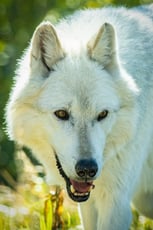Keystone Species
Ecologists have long understood food chains. The animal at the top, the prime predator in an...


This year I have become even more convinced that much of the wildlife in Eagle County and other areas of the state is declining. I have been unable to get hard data to prove it, but I have a lot of anecdotal reports from friends, fellow photographers, and regular citizens who have observed the same things or responded, “Now that you mention it.”
I have contacted several individuals who are more involved than most with wildlife. Their responses have been somewhat noncommittal, or they wish not to be quoted, perhaps because they don’t want to respond for their agencies. Those agencies include Colorado Parks and Wildlife (CPW), Department of Natural Resources (DNR), United States Forest Service (USFS), Bureau of Land Management (BLM), and National Park Service (NPS).

Animals like this Bobcat can be killed by pesticides and rodent poisons put out to kill or control other species when they feed on the carcasses of dead animals.
My observations are based on the fact that I have a degree in biology, worked as a Supervisory Park Ranger Naturalist in Rocky Mountain National Park for 15 years, and have been doing wildlife photography in Colorado since around 1975. I believe I am a keen observer and try to be as pragmatic as possible. What I observe from my area of the county may be different from the observation of others. I am aware and observe population fluctuations from year to year, but this is something different.
My wildlife photographs, that I can quickly access, go back to the early 2000’s when digital photography first became possible. I file my photos with titles in hard drives. They are in folders by the date I go shoot. The images are named with the subject and then filed in folders by date, month, and year. I recently went back as far as I could and looked at the same month, same location, and compared the number of photos over many years. I looked at the number of individual animals of one species and the total number of unique species in that month. What I discovered made it obvious to me that the number of animals and the number of species captured in the last few years is down. I am using more advanced equipment so that should allow me to get more and better photos. That does not seem to be the case.
Poisons are often put out to kill rodents, like this Wyoming Ground Squirrel. Many people consider them to be a problem, but they also kill animals that feed on the carcass.
My observations when I am in the field on my own or with friends tend to be different than past years. We visit areas where we might have photographed a number of bird species only to find a few of the more common birds and even those numbers seem down. We also don’t tend to find as many unique animals.
I have had bird feeders at my house for many years (that I take in at night to not have bear problems). I am going through less seed than past years. I created a “book” in 2014 using photographs I took of all the birds I had seen and photographed at my bird feeders in that one year. It contains 33 species. I counted this year’s observations and only saw 11 of those species.
 Many birds, like this Bullocks Oriole, were common birds at my feeders in the past. I have seen none this year.
Many birds, like this Bullocks Oriole, were common birds at my feeders in the past. I have seen none this year.
I used to fill a quart size hummingbird feeder more than once a week. I now put out a two cup feeder and refill it every week, not because it is empty, but because I don’t want mold to develop. I clean the feeder for the health of the birds. As I write this, I have not seen any hummingbirds at that feeder. In past years there would be numerous birds there and a lot of aggressive behavior, especially in late summer & fall. Not this year. River Otter tracks on the Colorado River are pretty obvious and were common in past years. I never saw any this year.
River Otter tracks on the Colorado River are pretty obvious and were common in past years. I never saw any this year.
Driving the Colorado River Road from Dotsero to State Bridge, in the winter to do some photography, usually revealed a lot of the distinctive tracks of river otters, mink, beaver, and often sightings of the animals. I photographed few otter last year and have seen none this winter on the river. I have often reported those numbers to the DNR in the past.
Rufous hummingbirds usually arrive at my house on the 4th of July. They did not show up until the last week of July this year and there are no Rufous guarding my feeder today. They are usually very active.

My sightings of raptors this winter, like this Rough Legged Hawk, were really low or non existent.
This winter I have not seen any Rough-legged Hawks and only taken two photos of Northern Harriers. They would be common most winters. There are three Golden Eagle nests I have been watching for several years, because they were close to a photographic vantage point from my car. They were all vacant this year and I have seen only a few in flight. Raptors, as a whole, seem to be less common. In the past I would often see them on posts and electrical poles as I drive around, but not that common this year.
 Many Golden Eagle nests I have watched for years were vacant this year.
Many Golden Eagle nests I have watched for years were vacant this year.
I have four trail cams at my house that have been running for 8-10 years. The number of animals that have shown up on those cameras is not what I have seen in past years. Fewer bears, bobcats, foxes, coyotes, and birds. The number of deer seems to be about the same.
I often photograph insects. In past years I had continual problems with paper wasps that would build wasp nests that resemble an open honeycomb, on the underside of my deck railing. I would use a water hose 3-4 times each summer to wash out the nests. I don’t like using killing sprays. Their numbers around my house are down, I have not gotten out the hose once this summer. Surprisingly a number of people I contacted asked, “Where are the bees and bumble bees?”
We can explain some of the demise of wildlife.
An internet search on “How can I protect wildlife?” will reveal a lot of information that may help you avoid being part of the problem.
What is your experience and what have your acquaintances observed?
The Eagle County Community Wildlife Roundtable is a collaborative partnership with the White River National Forest, Colorado Parks and Wildlife, Bureau of Land Management, local government entities, community members, and citizen scientists. The purpose of the Eagle County Community Wildlife Roundtable is to gather a group of diverse stakeholders in the valley to understand and address issues facing wildlife populations. Together we will identify a shared vision and realistic actions that the community can rally around to support wildlife. We want to leverage diverse values, creativity, and resources to move toward positive action.

Rick Spitzer is the author of the article and official photographer for Eagle County Community Wildlife Roundtable.


Ecologists have long understood food chains. The animal at the top, the prime predator in an...


Fire has been a common natural event in history, even before humans. Lightning historically ignited...